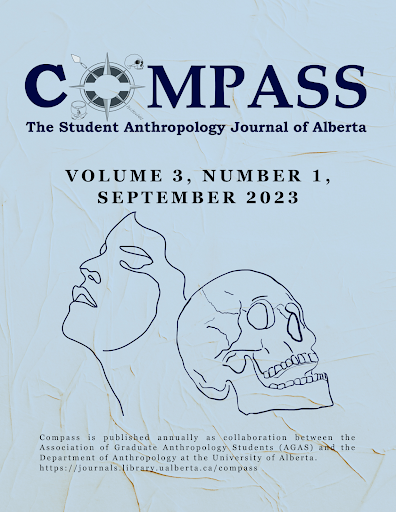Corinthian Pyxis: A Relative Dating and Contextual Analysis of Origin
DOI:
https://doi.org/10.29173/comp61Keywords:
Corinthian Period, Ancient Corinth, Origin, Contextual Analysis, Relative Dating, Pyxide Jar, Pyxis, Pottery, Ancient GreeceAbstract
Pyxide jars are not uncommon to excavate, as they were standard possessions of women throughout a significant portion of ancient Greece. However, the pyxis jar on display at the W.G. Hardy Classics Museum in Edmonton, Alberta, is suggested to be from a time period that is limited in terms of comparable pyxides. The W.G. Hardy Classics Museum gives no explanation as to where the pyxis jar was contextually found beyond originating from Corinth, and an estimation of being produced sometime within the seventh–sixth century BC. This article narrows the suggested time of production from the two-hundred-year period, as claimed by the museum, to specifically the Early Corinthian period, through a process of relative dating, as Corinth was becoming the production centre for pottery during the time within ancient Greece. Through an analysis of the physical condition, artistic motifs, and comparable pyxides, we are able to ascertain the particular context in which it would have been found, in addition to the timeframe of production, and the likely tools used through the manufacturing process.
References
Alexandropoulou, Anna. 2016. A fourth-century tomb at Argos: a contribution to the study of local pottery and burial customs. The Annual of the British School at Athens 111(1):183–225. doi:10.1017/S006824541500 0192.
Amyx, D. A. and Patricia Lawrence. 1975. Archaic Corinthian pottery and the Anaploga Well, vol. 7(2) of Corinth: results of excavations conducted by the American School of Classical Studies at Athens. Princeton, NJ: the American School of Classical Studies at Athens (ASCSA). https://www.jstor.org/stable/ 4390661.
Biers, William R. 1994. Mass production, standardized parts, and the Corinthian ‘plastic’ vase. Hesperia: The Journal of the American School of Classical Studies at Athens 63(4):509–16. https://www.jstor.org/stable/ 148210.
Blok, Josine H. and André P. M. H. Lardinois, eds. 2006. Solon of Athens: new historical and philosophical approaches. Leiden: Brill.
Bookidis, Nancy. 2003. The sanctuaries of Corinth. In Corinth, the Centenary: 1896–1996, vol. 20 of Corinth: results of excavations conducted by the American School of Classical Studies at Athens. Charles K. Williams II and Nancy Bookidis, eds. Pp. 247–259. Princeton, NJ: The American School of Classical Studies at Athens (ASCSA). https://www.jstor.org /stable/4390727.
Charalambidou, Xenia and Catherine Morgan, eds. 2017. Interpreting the seventh century BC: tradition and innovation. Oxford: Archaeopress.
Chaviara, Artemi and Eleni Aloupi-Siotis. 2016. The story of a soil that became a glaze: chemical and microscopic fingerprints on the Attic vases. Journal of Archaeological Science: Reports 7:510–518. https://doi.org/10.1016/j.jasrep.2015.08.016.
Dickey, Keith. 1992. Corinthian burial customs, ca. 1100 to 550 BC. PhD dissertation, Bryn Mawr College.
Domínguez, Adolfo J. and Carmen Sánchez. 2001. Greek pottery from the Iberian Peninsula: Archaic and Classical periods. Leiden: Brill.
Eiteljorg II, Harrison. 1980. The fast wheel, the multiple-brush compass and Athens as home of the Protogeometric style. American Journal of Archaeology 84(4):445–452.
Haggis, Donald C. 2018 Discussion and debate: in defense of a contextual Classical archaeology. Journal of Mediterranean Archaeology 31(1):101–119. https://doi.org/10.1558/jma.36812.
Hasaki, Eleni. 2022. Potters at work in Ancient Corinth: industry, religion, and the Penteskouphia Pinakes. Hesperia Supplements 51. https://www.ascsa.edu.gr/ publications/book/?i=9780876615539.
Hollowell, Julie. 2006. Moral arguments on subsistence digging. In The Ethics of Archaeology: Philosophical Perspectives on Archaeological Practice. Chris Scarre and Geoffrey Scarre, eds. Pp. 69–94. Cambridge: Cambridge University Press.
Osborne, R. 2016. De-contextualising and re-contextualising: why Mediterranean archaeology needs to get out of the trench and back into the museum. Journal of Mediterranean Archaeology 28(2):241–261. https://doi.org/10.1558/jmea.v28i2.29533.
Papadopoulos, John K., James F. Vedder, and Toby Schreiber. 1998. Drawing circles: experimental archaeology and the pivoted multiple brush. American Journal of Archaeology 102(3):507–529.
Pemberton, Elizabeth G. 2000. Wine, women and song: gender roles in Corinthian Cult. Kernos 13:85–106. http://jorunals.openedition.org/kernos/1295.
Richter, Gisela M. A. 1936. A Corinthian pyxis. The Metropolitan Museum of Art 31(5):104–105. https://www.jstor.org/stable/3256221.
Risser, Martha K. 2001. Corinthian conventionalizing pottery, vol. 7(5) of Corinth: results of excavations conducted by the American School of Classical Studies at Athens. Princeton, NJ: American School of Classical Studies at Athens (ASCSA). https://www.jstor.org /stable/4390667.
Schreiber, Toby. 1999. Athenian vase construction: a potter's analysis. Malibu, CA: J. Paul Getty Museum.
Shear, T. Leslie. 1939. Discoveries in the Agora in 1939. American Journal of Archaeology 43(4):577–588. https://doi.org/10.2307/498983.
Slane, Kathleen W. 2017. Tombs, burials, and commemoration in Corinth's Northern Cemetery, vol. 21 of Corinth: results of excavations conducted by the American School of Classical Studies at Athens. Princeton, NJ: The American School of Classical Studies at Athens (ASCSA).
Smith, H. R. W. 1936. CORPUS VASORUM ANTIQUORUM. United States of America: University of California, Fascicule 1. Cambridge, MA: Harvard University Press.
Tegerdal Hune, Josefine. 2022. Valley of connections: networks and spatiality in the archaeological landscape of the Morello Valley in central Sicily. MS thesis, Uppsala University, Sweden.
Vanschoonwinkel, Jacques. 2006. Greek migrations to Aegean Anatolia in the Early Dark Age. Greek Colonisation 1:115–141. https://doi.org/10.1163/ 9789047404101_004.
Wardle, Kenneth, Thomas Higham, and Bernd Kromer. 2014. Dating the end of the Greek Bronze Age: a robust radiocarbon-based chronology from Assiros Toumba. PLoS ONE 9(9). doi:10.1371/journal.pone.0106672.
Warren, C. P. W. 1970. Some aspects of medicine in the Greek Bronze Age. Medical History 14(4):364–377. doi:10.1017/S0025727300015817.
Weinberg, Saul S. 1943. The Geometric and Orientalizing pottery. The American School of Classical Studies at Athens 7(1):1–104.
Whitley, James, and Robin Osbourne. 2016. Fusing the horizons, or why context matters: the interdependence of fieldwork and museum study in Mediterranean archaeology. Journal of Mediterranean Archaeology 29(2):247–261. https://doi.org/10.1558/jmea.v29i2. 32574.
Downloads
Published
Issue
Section
License
Copyright (c) 2023 Mackenzie R. Lofgren

This work is licensed under a Creative Commons Attribution 4.0 International License.





